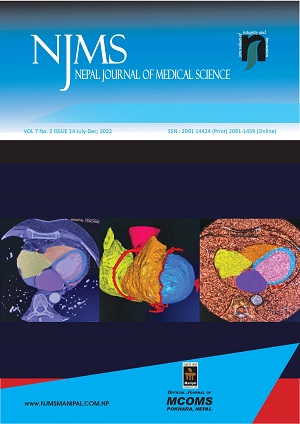Role of the American College Of Radiology –Thyroid Imaging Reporting and Data System (ACR TI-RADS) in Differentiating Benign and Malignant Thyroid Nodules
DOI:
https://doi.org/10.3126/njms.v7i2.47205Keywords:
FNAC, Biopsy, Thyroid NoduleAbstract
Introduction: Thyroid nodule is commonly detected while performing an ultrasound of the neck. American College of Radiology, Thyroid imaging reporting and data system (ACR-TIRADS) is a classification used to characterize thyroid nodules based on ultrasound findings. The objective of this study is to evaluate the role of ACR-TIRADS classification in differentiating benign and malignant thyroid nodules.
Methods: This is a prospective study conducted at Manipal Teaching Hospital. A total of 70 patients presenting to our radiology department for fine needle aspiration cytology (FNAC) of thyroid nodule were enrolled in the study. Thyroid nodules were grouped as 1- 5 according to the ACR-TIRADS. The ACR-TIRADS findings were correlated with FNAC and or biopsy findings as available. Subsequently; sensitivity, specificity, accuracy, positive predictive value and negative predictive value of ACR-TIRADS in differentiating benign from malignant nodules were assessed.
Results: Mean age of patients in our study was 52.16 years (18-89 years). Male patients were 11 (15.7 %) and female were 59 (84.30 %). According to Ultrasonography; 1.4% of thyroid nodules were labelled as ACR-TIRADS 1; 21.4% as ACR-TIRADS 2; 32.85% as ACR- TIRADS 3; 28.6 % as ACR-TIRADS 4 and 15.7 % as ACR-TIRADS 5. ROC curve analysis showed AUC of 0.78 (95% CI). ACR-TRIADS had sensitivity, specificity, positive predictive value, negative predictive value, diagnostic accuracy of 87.5%, 68.5 %, 45.16 %, 94.87 %, 72.86 % respectively.
Conclusion: ACR- TIRADS has high sensitivity and accuracy in differentiating benign and malignant thyroid nodules.
Downloads
Downloads
Published
How to Cite
Issue
Section
License
Copyright (c) 2022 Nepal Journal of Medical Sciences

This work is licensed under a Creative Commons Attribution 4.0 International License.
Copyright © by Nepal Journal of Medical Sciences. The ideas and opinions expressed by authors of articles summarized, quoted, or published in full text in this Journal represents only opinions of authors and do not necessarily reflect the official policy of Nepal Journal of Medical Sciences or the institute with which the author(s) is (are) affiliated, unless so specified.




